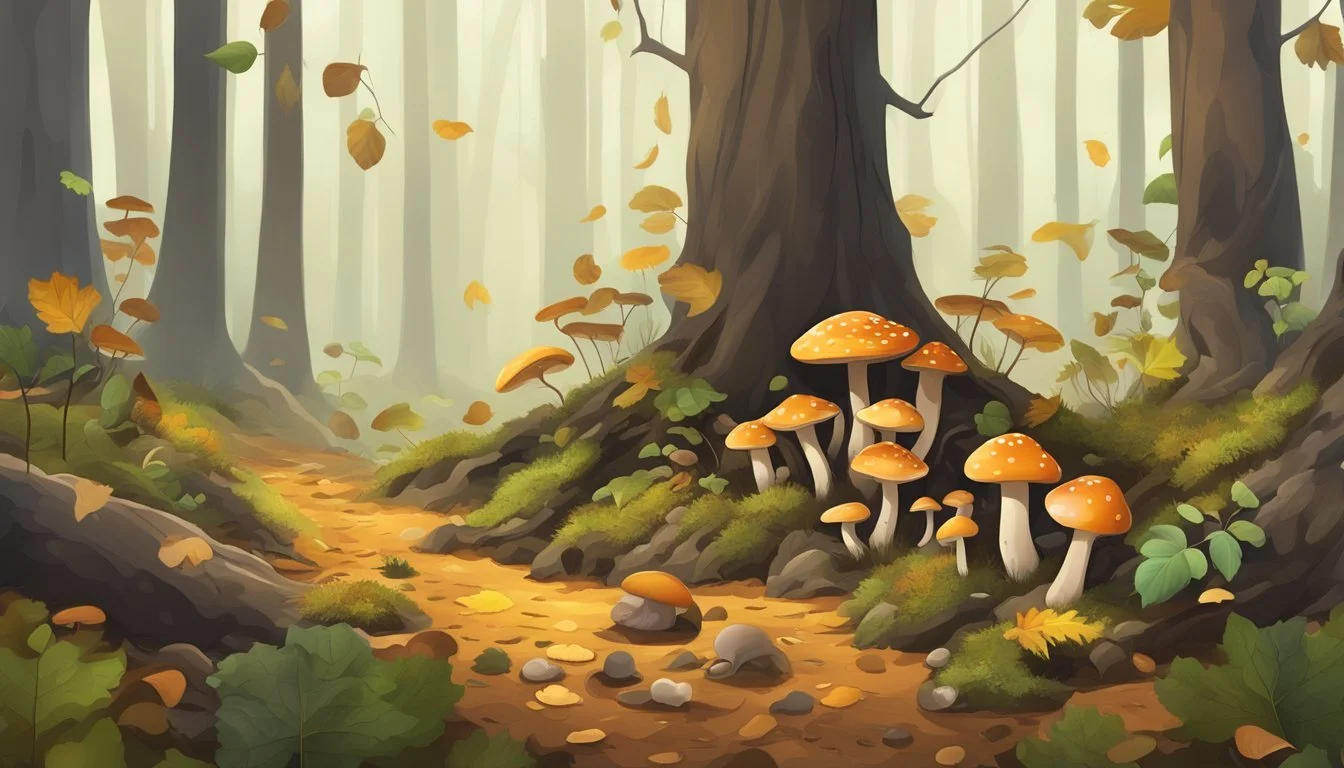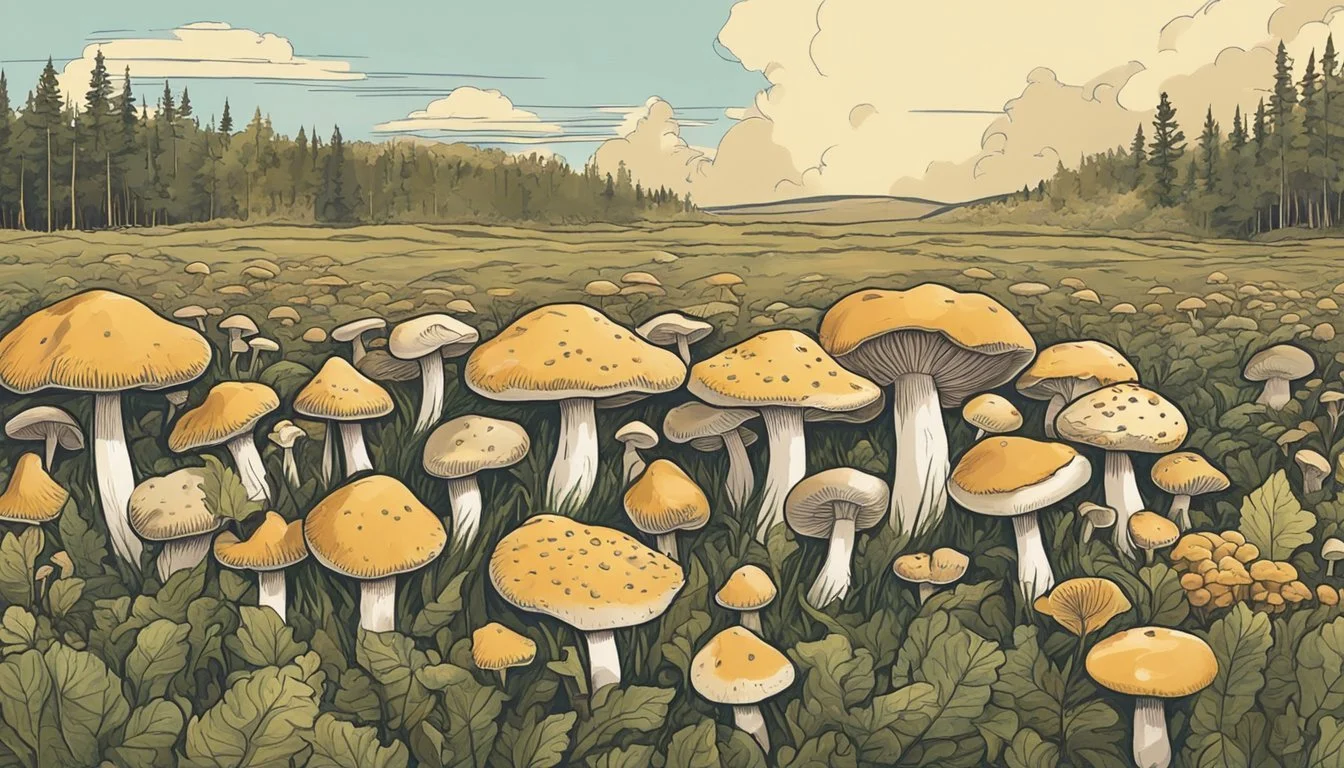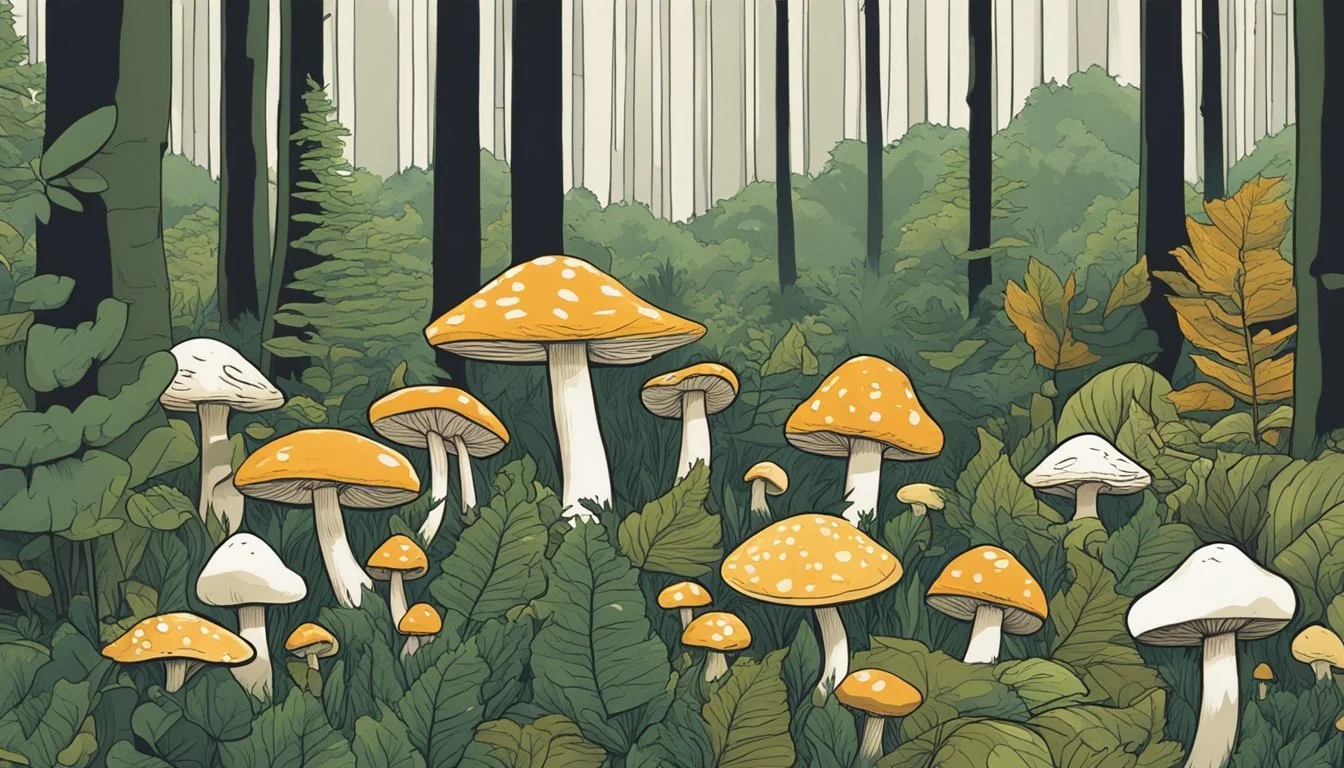Mushroom Hunting South Dakota
A Guide to Prime Locations and Seasonal Tips
This Article is Part of Our Guide on Mushroom Hunting for All 50 States
Mushroom hunting in South Dakota offers enthusiasts the opportunity to explore the state's diverse ecosystems while engaging in the enjoyable pursuit of foraging for edible fungi. The region's climate and soil conditions create an ideal environment for a variety of mushrooms (What wine goes well with mushrooms?) to thrive, particularly in river valleys and under certain trees, such as ash and aspen. The state's landscapes, rich with calcareous and loamy soil, become a fertile ground for mushrooms, with the most sought-after being the morel.
The mushroom season in South Dakota predominantly spans from late March to May, coinciding with the warming of the soil which prompts the mushrooms to emerge. During this period, mushroom hunters, equipped with their knowledge of the local terrain and growth conditions, eagerly anticipate the appearance of morels and other native species. For those new to foraging, identifying the edible species such as the Dryad's Saddle, Chicken of the Woods, Pear-shaped Puffball, and Oyster Mushrooms is a crucial skill, with resources available to help discern these from inedible or toxic varieties.
Foraging for More Than Just Mushrooms in South Dakota
South Dakota's vast prairies and rugged forests offer a surprising bounty for foragers seeking more than just mushrooms. From flavorful wild plums and juicy chokecherries to nutritious lamb's quarters and aromatic wild sage, the Mount Rushmore State's diverse landscapes provide a wealth of wild edibles. Embark on a foraging adventure in South Dakota's untamed wilderness.
👉 Foraging for Wild Edibles in South Dakota
Commonly Found Edible Mushrooms in South Dakota
South Dakota is home to several edible mushroom species. Some of the most commonly found edible mushrooms in the state include:
Pheasant Back Mushroom (Cerioporus squamosus): Also known as the dryad's saddle, this mushroom has a unique shape resembling the feathers of a pheasant. It has a mild, earthy flavor and is commonly found growing on dead or dying hardwood trees in South Dakota.
Morel Mushroom (Morchella spp): Morel mushrooms are highly prized for their distinctive honeycomb appearance and earthy, nutty flavor. They are often found in wooded areas and are a popular choice for foragers in South Dakota.
Chanterelle Mushroom (Cantharellus spp): Chanterelles are golden or yellow mushrooms with a delicate, fruity aroma and a mild, peppery taste. They are commonly found in South Dakota's forests and are sought after for their culinary uses.
Oyster Mushroom (Pleurotus spp): Oyster mushrooms have a delicate, slightly sweet flavor and a tender texture. They can be found growing on decaying wood and are popular for their versatility in cooking in South Dakota.
It is essential to properly identify any mushroom before consuming it, as some species can be poisonous. Beginners should go mushroom hunting with an experienced guide or join a local mycological society to learn how to identify edible mushrooms safely.
Basics of Mushroom Hunting in South Dakota
Mushroom hunting in South Dakota is a rewarding activity that requires proper equipment, knowledge of morel mushrooms, identification skills for edible varieties, and awareness of poisonous species.
Essential Equipment
Successful mushroom forays start with the right gear. Mushroom hunters typically need:
A basket or mesh bag to allow spore dispersal.
A small knife for clean cuts.
A field guide for mushroom identification.
Comfortable hiking footwear and weather-appropriate clothing.
GPS or a map for navigation.
Plenty of water and snacks for longer excursions.
Understanding Morel Mushrooms
Morels are a coveted find in South Dakota. They usually appear:
In loamy, calcareous soil with a pH above 6.
Near ash or aspen trees as common host trees.
From late March to May, varying with latitude.
Morels are distinct, with a honeycombed cap attached directly to the stalk, and they never have a detached cap like some mushrooms.
Recognizing Edible Mushrooms
Edible mushrooms in South Dakota may include:
Common Name Description Chicken of the Woods Bright orange, shelf-like fungus on trees Oyster Mushrooms White or pale, fan-shaped caps Puffballs Round, puffing spores when mature
Hunters must verify their finds with a reputable guide, as edible mushrooms often have toxic lookalikes.
Dangers of Poisonous Mushrooms
Recognizing poisonous mushrooms is vital for safety. Dangerous species may exhibit:
Amanita-like features such as white gills, a skirt or ring on the stem, and a bulbous base.
Bright warning colors, though not all colorful mushrooms are toxic.
When in doubt, one should never consume a wild mushroom. Only those with 100% certainty of a mushroom's identity should consider consuming it, and those new to foraging should consult experienced mycologists or local mushrooming societies.
Foraging Guidelines and Best Practices
Mushroom hunting in South Dakota offers a unique experience for nature enthusiasts, but it is crucial to approach this activity responsibly. Legal considerations, sustainable harvesting techniques, and safety tips are imperative for a successful foray.
Legal Considerations
In South Dakota, mushroom hunters must adhere to state and local regulations concerning foraging. Public lands may allow foraging, but it is essential to check if a permit is required. Private property access requires explicit permission from the landowner. Hunters should familiarize themselves with South Dakota’s trespassing laws to avoid legal issues.
Sustainable Harvesting Techniques
Foragers should employ practices that ensure the continued growth of mushroom populations. Here are several techniques:
Selectively Harvest: Take only mature specimens, leaving young mushrooms to mature and spore.
Cut Don't Pull: Use a knife to cut mushrooms above the ground to protect the mycelium below.
Bag Separately: Carry different species in separate bags to avoid cross-contamination.
Safety Tips for Mushroom Hunters
Mushroom foraging can pose risks; therefore, hunters should follow safety precautions to avoid harm:
Positive Identification: Only consume mushrooms one is 100% certain are non-toxic.
Dress Appropriately: Wear long sleeves and pants to prevent tick bites and other hazards.
Check for Ticks: After foraging, hunters should thoroughly inspect themselves and their gear for ticks.
Understanding South Dakota's Ecosystems
In exploring South Dakota's diverse ecosystems, it is vital to recognize the unique interaction between the soil, flora, and topography that offers an array of habitats suitable for mushroom growth. The state's varied landscapes, from the Black Hills to riverine valleys, significantly influence where different fungi species can flourish.
Key Habitat Features
South Dakota's ecosystems are defined by distinct habitats that contribute to fungal biodiversity. The Black Hills region, known for its mixed forests, creates an environment rich in organic material where numerous fungi thrive. In contrast, the river bottoms provide moist soils and decaying wood, which are ideal conditions for mushroom species like the sought-after morel.
Altitude and aspect play crucial roles, with south-facing slopes in the Black Hills often warmer and drier, affecting the distribution of mushroom species. The forests contain various trees, such as ash and aspen, which are critical for the growth of certain fungi due to their symbiotic relationships.
Soil Types and Fungus Growth
The soil in South Dakota ranges from sandy soils in the east to more calcareous, loamy grounds towards the west. The soil type directly impacts fungus growth, as certain mushrooms favor the higher pH levels found in calcareous soils.
Sandy Soil: Typically found in eastern South Dakota along river valleys.
Calcareous and Loamy Soil: More common in western parts of the state, particularly the Black Hills.
The topography of an area, such as the rolling hills and flat prairies, influences drainage and moisture levels, further dictating the type of fungi that can grow there. For better success in mushroom hunting, one should understand these environmental factors and their relationship with fungal life cycles.
Identifying Prime Mushroom Locations
Successful mushroom hunting in South Dakota largely depends on knowing where to look. The state's varied terrain offers diverse habitats, each conducive to different mushroom species.
Black Hills and Badlands
Black Hills: This region is known for its dense forests and higher elevation, providing a favorable environment for mushrooms due to the moist, cool climate. Hunters often find edible varieties among the spruce and pine trees. The natural shade and organic matter contributed by these forests create ideal conditions for a range of fungi.
Badlands: Although the Badlands might seem inhospitable for mushroom growth, the area's microclimates, where moisture can accumulate, provide surprise niches for mushrooms. Inspecting around protected depressions and gulches might lead to successful finds.
River Bottoms and Moist Areas
Areas adjacent to rivers, streams, and moist regions in South Dakota are excellent places for mushroom hunting, particularly after rainfall. These locations offer the damp soils and decaying organic matter where mushrooms thrive. Look for areas with a mix of shade and sunlight, as these conditions can encourage mushroom growth.
Host Trees for Morels
Morels, sought after by many enthusiasts, have specific tree preferences which make certain areas more promising:
Ash: These trees create an alkaline soil condition, where morels are known to flourish.
Elm: Dying or dead elms provide a well-known habitat for morels, with a preference for trees that have been dead for a couple years.
Aspen: These trees, especially in groves where the soil is undisturbed, can support the growth of morels.
Cottonwood: River bottoms with cottonwoods are often fruitful grounds, as morels appear to associate with these trees in floodplains.
When seeking morels, identifying these host trees can greatly increase the chances of a successful hunt.
Seasonal Patterns and Timing
Mushroom hunting in South Dakota follows distinct seasonal patterns, and timing is key for foragers looking to harvest edible fungi. Understanding when to hunt and the specific conditions required for mushrooms to thrive can significantly enhance one's foraging success.
Morel Season in South Dakota
Morel mushrooms, a sought-after delicacy, typically emerge in South Dakota during the spring season. The prime time for morel hunting is a concise window from late March to May. During this period, foragers eagerly venture into the state's river valleys and forested areas, where morels are known to flourish.
Start of Season: Often tied to the warming of soil temperatures which should reach about 45 to 50 degrees Fahrenheit.
End of Season: As spring progresses into summer, morel mushrooms become less abundant, marking the end of the productive season.
Weather and Soil Conditions
The growth of mushrooms, including morels, is largely influenced by weather and soil conditions.
Soil Temperature: For morels in particular, soil temperature should ideally be between 45 and 50 degrees Fahrenheit.
Precipitation: Adequate rainfall is necessary, as it moistens the soil and creates ideal conditions for morels to grow.
Specific Conditions: Morels tend to favor calcareous and loamy soil with a pH level above 6, often found near ash or aspen trees.
Foragers should monitor local weather forecasts and soil conditions closely to determine the best time to head out on their mushroom hunting expeditions.
Preparation and Use of Mushrooms
When foraging and preparing mushrooms in South Dakota, it is crucial to clean, store, and cook them properly to ensure maximum flavor while preserving their natural textures. Preservation methods are also vital for long-term use and safety.
Cleaning and Storing Morels
Before storing, morels should be thoroughly rinsed to remove any dirt and debris. It is recommended to soak morels in salt water for a brief period to dislodge any insects. They should then be dried on paper towels. For storage, morels can last for a short time in a refrigerator when kept in a container that allows air circulation, such as a paper bag.
Cooking Techniques
There are several methods to cook mushrooms, but frying is popular for its ability to enhance flavor and texture. Morels, for instance, can be sautéed in butter for a rich taste. To fry mushrooms:
Heat a pan with a tablespoon of butter.
Add cleaned mushrooms to the hot pan.
Sauté the mushrooms until they are golden brown.
Season with a pinch of salt to taste.
Preservation Methods
For preserving the mushrooms, two techniques stand out:
Canning: Mushrooms can be canned by boiling them for approximately 15 minutes, then placing them in sterilized jars with a pinch of salt and boiling water.
Drying: Morels and other mushrooms can be dehydrated and stored for long-term use.
Method Instructions Canning Boil mushrooms, add to jars with salt, cover with boiling water. Drying Slice and spread out mushrooms; dry in a dehydrator or warm, airy space.
Once preserved, these mushrooms can be reconstituted and used in various dishes throughout the year.
Additional Mushroom Varieties
In South Dakota, mushroom hunters have a variety of species to discover beyond the well-known morels. Each mushroom offers a unique foraging experience and boasts distinctive flavors suited to gourmet recipes.
Chanterelles and Oyster Mushrooms
Chanterelles are prized for their rich, peppery flavor and can be identified by their yellow to orange color and funnel-shaped bodies. Foragers should note their appearance from late summer to fall. Oyster mushrooms (Pleurotus ostreatus), on the other hand, are known for their delicate texture and are often found on the sides of trees, preferring deciduous woods.
Boletes and Shaggy Mane
Boletes encompass a range of species, all having a characteristic sponge-like layer under their caps instead of gills. They vary in color and size and are known for their nutty, earthy flavors. (What wine goes well with earthy flavors?) The Shaggy Mane (Coprinus comatus) is easily recognizable by its tall, cylindrical white cap covered in shaggy scales. This mushroom often appears in disturbed soils near roadways or lawns after rain.
Tools for Mushroom Hunters
A successful mushroom hunt in South Dakota hinges on two critical components: reliable identification methods and up-to-date mushroom maps. These tools equip hunters with the necessary information to safely forage wild mushrooms, considering the specific growth conditions they require, such as levels of acidity or alkalinity in the soil.
Field Guides and Identification
Field guides offer extensive details on various mushroom species, including their appearance and habitat. Arguably the most crucial tool for a mushroom hunter, they assist in distinguishing edible fungi from potentially toxic look-alikes. Spore prints, a technique featured in these guides, provide an additional layer of identification, helping to verify the type of mushroom by the color and pattern of its spores.
Essential identificati0n tools:
Quality Knife: For cutting mushrooms at the stem base
Basket or Bag: For collecting and transporting mushrooms
Field Guide: For mushroom species identification
Mushroom hunters should always cross-reference multiple sources before consuming any wild mushrooms, as identification errors can lead to serious health risks.
Mushroom Maps and Applications
Mushroom maps and applications serve as navigational aids, pointing hunters to areas where mushrooms are likely to grow based on current and past growing conditions. They incorporate real-time reports and historical data, guiding foragers to locations with ideal soil conditions—whether acidic or alkaline—where certain mushroom species are known to thrive.
Digital tools for hunters:
Mushroom Maps: Provide location-based guidance
Mobile Applications: Offer real-time updates on mushroom hotspots
With the aid of these advanced tools, mushroom hunters can maximize their time in the field and increase their chances of a rewarding forage. However, technology should be complemented with traditional methods to ensure a safe and successful hunt.
Conservation and Ecology
In South Dakota, the practice of mushroom foraging must take into consideration the conservation of forests and the intricate ecology of the region. Responsible foraging is key to maintaining the health and balance of the local ecosystems.
Impact of Foraging on Local Ecosystems
Mushroom foraging, when done without regard for ecology, can disturb the natural recycling process of forests. Each mushroom plays a role in breaking down organic matter, which enriches the soil and supports the growth of various plant species. The collection of mushrooms, particularly when excessive or done with damaging techniques, can lead to:
Reduction in fungal biodiversity: Overharvesting specific species, like the sought-after morels, can decrease their population, affecting forest ecology.
Soil disruption: Aggressive searching and harvesting methods may disturb the soil structure and harm the underlying mycelial networks vital for nutrient distribution to trees.
Habitat alteration: The removal of large quantities of mushrooms may affect other species that rely on fungi for food, like insects and small mammals.
To mitigate negative impacts, foragers are encouraged to adhere to principles of conservation. These include:
Using mesh bags for harvesting to allow spore dispersal.
Harvesting selectively, taking only what is needed and leaving behind smaller specimens to grow and spread.
Avoiding raking or digging into the soil, which can damage the mycelium and future mushroom production.
Understanding and respecting local regulations regarding protected areas and species.
Through conscientious practices, foragers contribute to the sustainability of South Dakota's rich forest landscapes, ensuring that mushrooms and the ecosystems they inhabit thrive for future generations.








